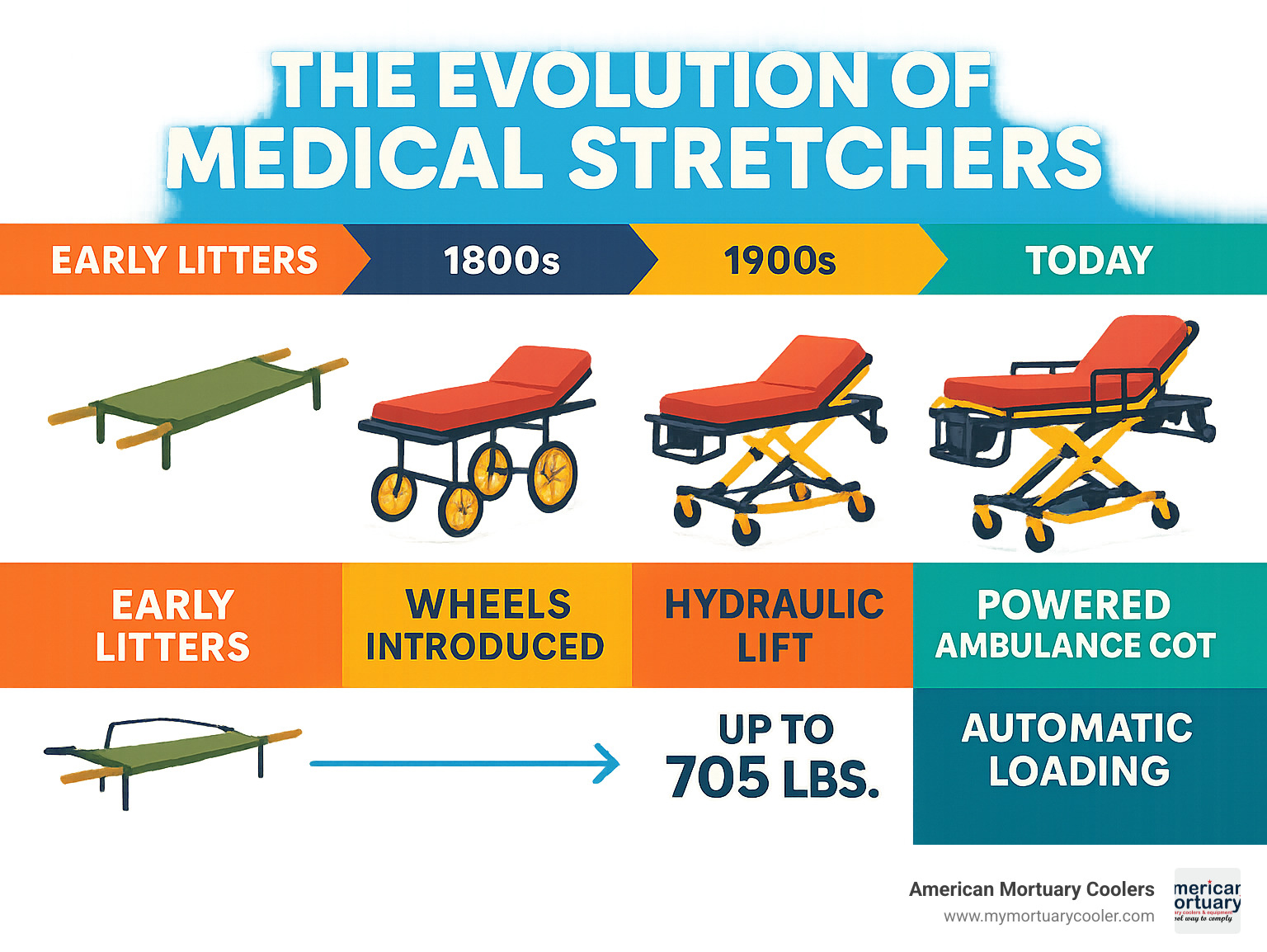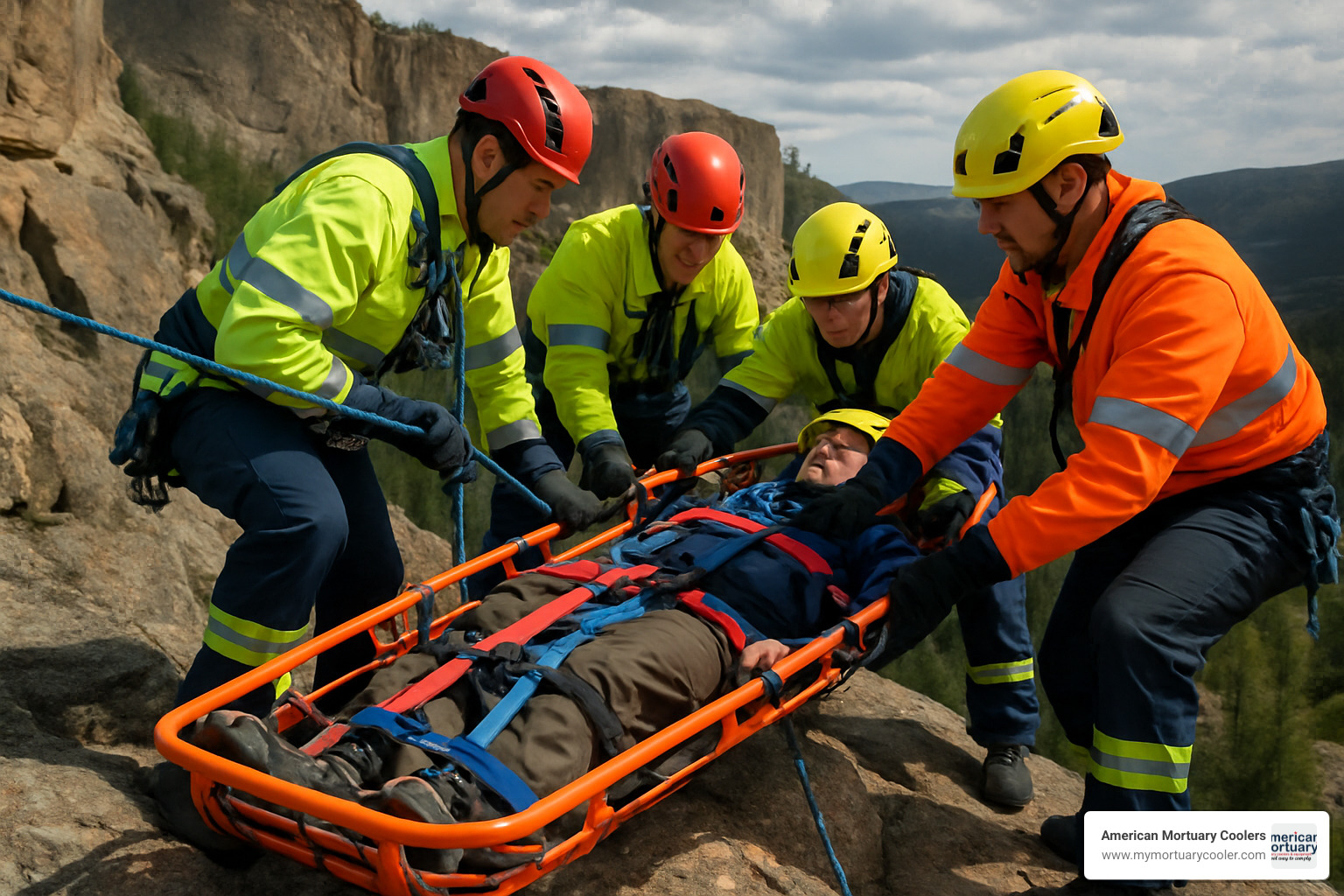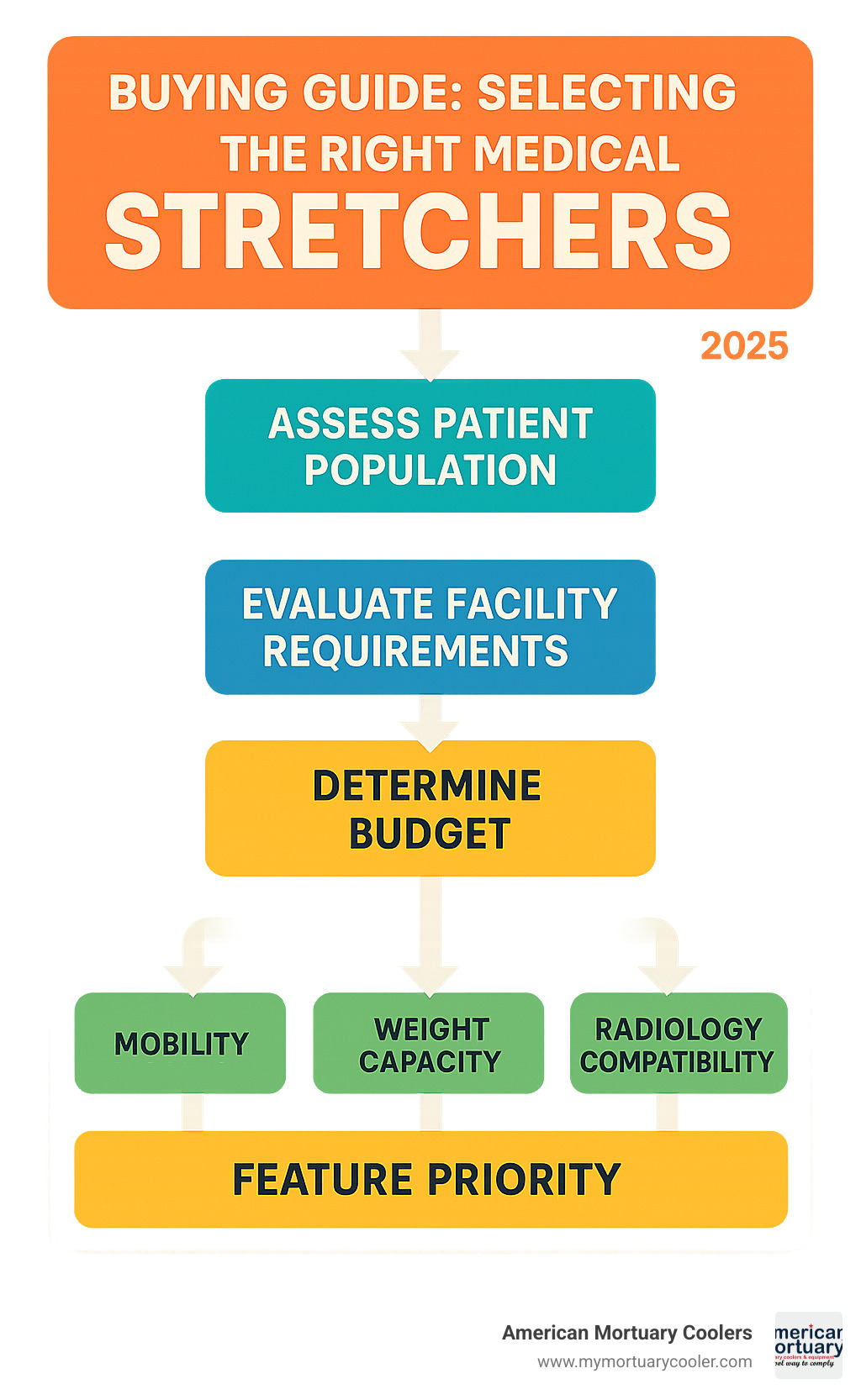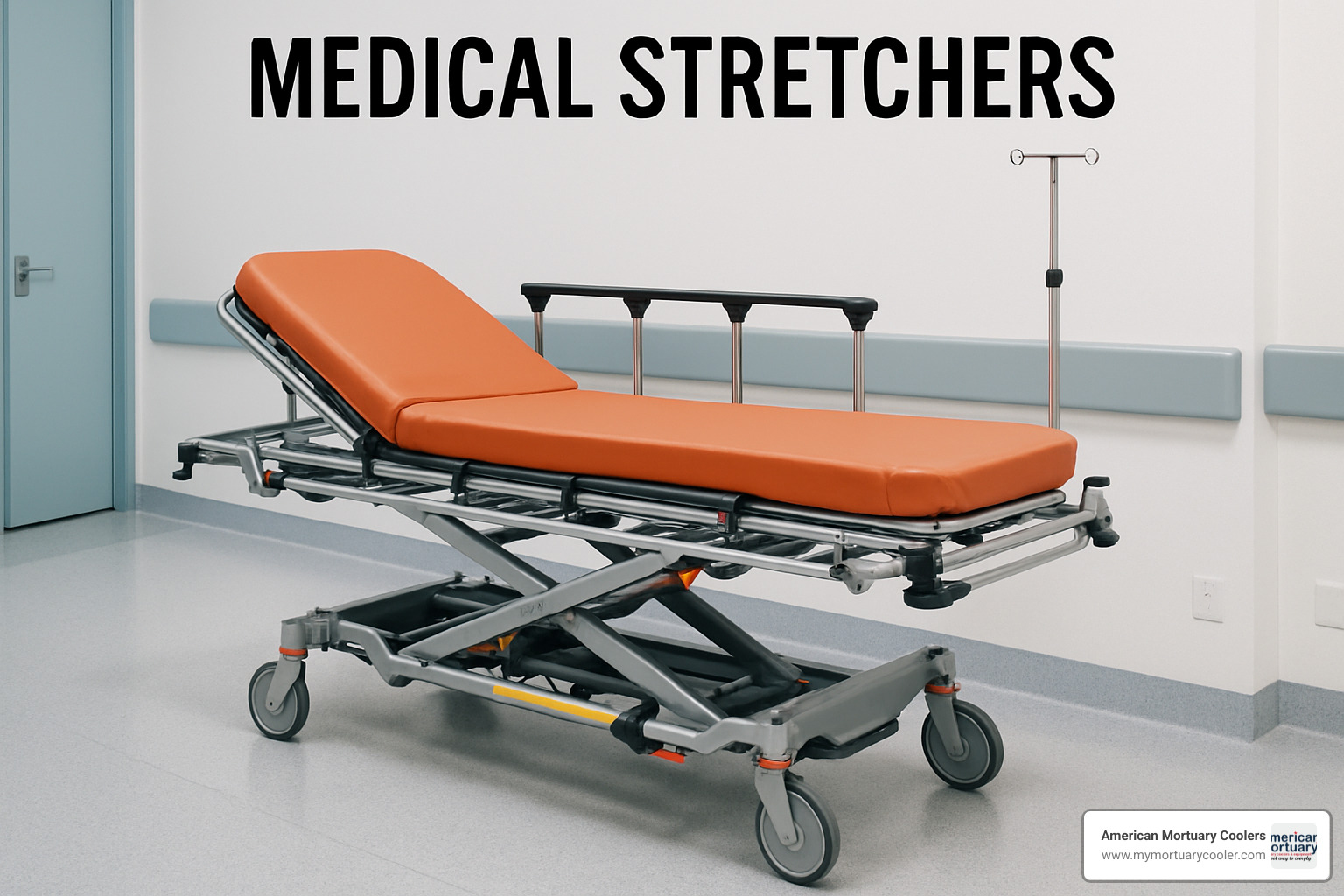Why Medical-Stretchers Are Critical for Patient Care and Safety
Medical-stretchers are specialized transport devices that let caregivers move patients who can’t walk or sit upright. From routine transfers inside a hospital to life-saving evacuations in the field, stretchers form the backbone of safe patient handling.
Key Types of Medical-Stretchers:
- Transport stretchers – Standard wheeled units for everyday hospital moves
- Ambulance stretchers – Heavy-duty cots with automatic vehicle loading systems
- Emergency stretchers – Lightweight, portable models for rescue scenarios
- Specialty stretchers – Bariatric, pediatric, MRI-compatible and more
- Mortuary stretchers – Multi-level cots for respectful post-mortem transport
Modern designs offer height adjustment, hydraulic lifts, and secure restraints that protect both patients and staff. Because patient handling is a leading cause of musculoskeletal injury among caregivers, choosing the right equipment is as much about workplace safety as it is about patient care.
Today’s stretcher market is vast—over 100 manufacturers and hundreds of models—but the principle stays the same: match the stretcher’s capabilities to the mission at hand. During my years supplying equipment to funeral homes and healthcare facilities nationwide, I’ve watched organizations boost efficiency and preserve dignity simply by upgrading to purpose-built medical-stretchers.

Medical-stretchers terms simplified:
What Is a Medical Stretcher & Major Categories
Think of a medical stretcher as a mobile bed created to move people who can’t walk on their own. The words “stretcher,” “gurney,” and “litter” often overlap—technically, a litter has no wheels, while gurneys and stretchers do.
Medical-stretchers serve four key purposes: safe transport, an on-the-go treatment platform, ergonomic support for caregivers, and proper patient positioning for procedures.
Standard models carry 350–500 lb, while bariatric units reach 705 lb. That safety margin matters when every pound counts.
The Spectrum of Medical-Stretchers: From Ambulance to Bariatric
- Ambulance stretchers feature automatic loading and height ranges that lock into vehicles.
- Folding stretchers weigh as little as 3 kg for tight rescue situations.
- Scoop stretchers split lengthwise to “scoop” spinal-injury patients without rolling them.
- Basket stretchers excel on rugged terrain and fold for compact storage.
- Stair stretchers include tracks or special wheels for confined staircases.
- Mortuary, pediatric, bariatric, and MRI-safe models address very specific needs.
How Medical Stretchers Evolved Over Time
From hand-carried litters of ancient armies to wheeled hospital gurneys, progress has centered on reducing physical strain and improving patient safety. Wheels cut labor; hydraulic lifts reduced manual hoisting; today’s powered cots and fifth-wheel drives make heavy transports routine for a single caregiver.
Core Design Elements: Materials, Ergonomics & Tech

The construction materials of medical-stretchers directly impact their performance, durability, and safety. Understanding these materials helps facilities make informed purchasing decisions.
Aluminum Alloy is the most common material for modern stretchers, offering an excellent strength-to-weight ratio. High-strength aluminum alloy frames provide durability while keeping overall weight manageable for caregivers.
Stainless Steel offers superior corrosion resistance and is often used in mortuary and laboratory settings where frequent cleaning with harsh chemicals is required. While heavier than aluminum, stainless steel provides exceptional longevity.
Carbon Fiber represents the premium option, offering the highest strength-to-weight ratio and radiolucent properties for imaging procedures. Carbon fiber stretchers are particularly valuable in MRI environments and high-end surgical suites.
Antimicrobial Polymers are increasingly used for surfaces and components that require frequent disinfection. These materials help prevent healthcare-associated infections while maintaining durability.
Ergonomic design features have become critical as healthcare facilities recognize the importance of protecting caregiver health. Modern stretchers include:
- Gas-assisted back lifts that reduce manual effort
- Ergonomic control placement for natural hand positions
- Powered height adjustment to eliminate manual lifting
- Fifth-wheel systems for easier steering and positioning
Technology integration continues advancing with features like:
- Hydraulic height adjustment with eight different positions
- Electric drive systems for powered transport
- Trendelenburg positioning (±18° range) for medical procedures
- Radiolucent decks for X-ray compatibility
Safety & Comfort Features Every Stretcher Should Offer
Patient safety and comfort should be non-negotiable features in any medical-stretcher selection. Essential safety features include:
Side Rails with secure locking mechanisms prevent patient falls during transport. Modern rails often feature quick-release mechanisms for emergency access while maintaining security during normal operations.
Restraint Belts should be adjustable and comfortable while providing secure patient positioning. Multiple belt configurations allow customization based on patient needs and medical conditions.
Pressure-Relief Mattresses are crucial for patient comfort during extended transport or procedures. Many stretchers now include latex-free, antibacterial, and flame-retardant mattresses as standard equipment.
IV Poles and Oxygen Tank Holders integrate essential medical equipment directly into the stretcher design, reducing clutter and improving mobility during transport.
Brake and Steer Pedals should be easily accessible and provide reliable control. Advanced systems include individual wheel braking and steering lock features for improved safety.
For facilities considering different stretcher types, understanding the distinctions is crucial. Our detailed comparison of Medical Stretcher vs Mortuary Stretcher explains the heavy-duty differences between these specialized units.
Application-Specific Stretchers: Matching Design to Mission

Choosing the right medical-stretchers is like picking the right tool for the job - you wouldn't use a hammer to fix a watch, and you wouldn't use a basic transport stretcher for a cliff rescue. Each setting has unique demands that require specific features and capabilities.
When EMTs respond to a mountain rescue, they need something completely different from what a hospital orderly uses to move patients between floors. The emergency scene demands lightweight, portable units that can handle rough terrain and tight spaces. Meanwhile, routine hospital transport prioritizes smooth rolling and patient comfort during those long hallways trips.
Emergency scene applications rely on ultra-lightweight designs that can steer challenging environments. Some rescue stretchers weigh as little as 3 kg but can still support a 450+ pound patient. These units often fold down for compact storage in rescue vehicles - the MOBI 6AB model, for example, shrinks from 85" × 24" × 7.5" to just 51" × 24" × 10" when folded.
Hospital transport focuses on different priorities entirely. These medical-stretchers need smooth wheels that won't jar patients, height adjustment to match different bed levels, and integration with existing hospital systems. Patient comfort becomes paramount when someone's already dealing with illness or injury.
Emergency & Transport Medical-Stretchers
The backbone of emergency medical services, these medical-stretchers handle everything from routine transfers to life-or-death situations. They're built tough because they have to be - there's no room for equipment failure when someone's life is on the line.
Automatic loading systems have been a game-changer for ambulance crews. Instead of three people struggling to lift a heavy stretcher into an ambulance, one person can now operate the system with the push of a button. The MOBI 3D2 and similar models eliminate the back-breaking work that used to plague EMS personnel, while handling patients up to 500 pounds.
These systems aren't just about convenience - they're about crash durability too. When an ambulance hits the brakes hard or takes a sharp turn, the stretcher's locking mechanisms and reinforced frame keep patients secure.
Multi-height adjustment might seem like a small feature, but it's crucial for compatibility. With eight different height positions, these stretchers can interface with various ambulance configurations and match hospital bed heights perfectly.
The fifth-wheel systems like the IndiGo™ powered fifth wheel deserve special mention. These touch-activated power assist systems make maneuvering feel effortless, even in tight hospital corridors or cramped ambulance bays.
For anyone wanting to dive deeper into transport options, our comprehensive guide Medical Stretchers 101: Everything You Need to Know covers all the essential selection criteria you'll need.
Specialty Stretchers for Bariatric, Pediatric & Imaging
Not every patient fits the "standard" mold, and that's where specialty medical-stretchers really shine. These units are purpose-built for specific populations and medical procedures, with features you won't find on regular transport stretchers.
Bariatric stretchers handle what regular stretchers simply can't. With capacity up to 705 pounds (320 kg), units like the QA3 stretcher feature reinforced frames and expanded surfaces that don't compromise on maneuverability. The gas-assisted back lift means staff don't have to strain when positioning larger patients.
Pediatric stretchers scale everything down appropriately for children and infants. Crib-style designs provide secure containment for very young patients while maintaining the mobility needed for hospital transport.
MRI-compatible stretchers solve a tricky problem - how do you transport patients into a machine that's essentially a giant magnet? The answer is non-magnetic materials like carbon fiber and specialized polymers. These units ensure patient safety in high-field magnetic environments without compromising structural integrity.
Radiology applications need something special too. Carbon fiber X-ray decks allow radiation to pass through without interference, giving clear images while supporting the patient safely.
Mortuary & Post-Acute Stretchers
Working in the funeral industry teaches you that dignity matters just as much after death as it does in life. Medical-stretchers for mortuary applications focus on respectful handling and ease of use for funeral service professionals.
Multi-level cots provide the flexibility needed for different procedures and storage configurations. The MOBI F500™ Multi-Level Mortuary Stretcher exemplifies this design with adjustable height capabilities that work seamlessly with various mortuary equipment.
Cadaver lifts with powered assistance reduce the physical demands on funeral service personnel while maintaining the dignity that families expect. These systems eliminate the awkward lifting and positioning that can make an already difficult job even harder.
Cooler integration features streamline the workflow from transport to storage. When stretchers interface directly with mortuary cooling systems, it creates a smooth, respectful process that honors both the deceased and their families.
At American Mortuary Coolers, we've worked with funeral homes across Tennessee, Georgia, Illinois, and throughout the contiguous 48 states. We understand that mortuary applications have unique requirements that standard medical equipment often can't meet. For detailed information about mortuary-specific options, our Complete Guide to Comparing Mortuary Stretcher Options walks through everything you need to know.
The right stretcher makes all the difference in providing dignified, professional service during families' most difficult times.
Buying Guide: Selecting the Right Medical-Stretchers

Choosing the right medical-stretchers can feel overwhelming with so many options available. After years of helping healthcare facilities across all 48 contiguous states, I've learned that the best purchases happen when you take time to really understand your needs before shopping.
Think of it like buying a vehicle - you wouldn't choose a sports car for hauling equipment, and you wouldn't pick a heavy truck for quick city trips. Medical-stretchers work the same way. Your setting, patients, and daily operations should drive your decision.
Your facility type makes a huge difference. Hospital transport stretchers need smooth rolling wheels and height adjustment for bed transfers. Emergency responders need lightweight, durable units that can handle rough terrain. Mortuary operations require different features entirely - dignity, ease of handling, and integration with cooling systems.
Patient population directly impacts weight capacity needs. Standard stretchers handle 350-500 lbs, but bariatric models support up to 705 lbs. If you serve an aging population or specialize in certain medical conditions, factor this into your selection.
Adjustability features like Trendelenburg positioning, backrest flexibility, and height adjustment can make or break daily operations. Eight-position height systems ensure compatibility with different vehicles and equipment.
Don't overlook certifications and warranties. FDA, CE, and ISO 9001 certifications ensure you're getting equipment that meets safety standards. Comprehensive warranties protect your investment - quality stretchers often provide 20+ years of reliable service.
The financial side matters too. Total cost of ownership includes more than the sticker price. Factor in maintenance costs, replacement parts availability, staff training time, and expected service life. Section 179 tax benefits let businesses deduct the full purchase price of qualifying medical equipment in the year it's placed in service, with 2024 deduction caps of $1,220,000.
Accessories & Add-Ons That Expand Capability
Smart accessories can transform basic medical-stretchers into specialized workhorses. Rather than buying multiple units, the right add-ons often provide better value and flexibility.
IV poles integrate essential equipment directly into your stretcher design. Adjustable models accommodate various configurations while maintaining stability during transport. No more juggling separate poles and equipment.
Fifth-wheel kits retrofit existing stretchers with powered maneuvering capabilities. These systems dramatically reduce physical strain on your staff while improving patient transport efficiency. The upgrade often pays for itself through reduced injury costs.
Power assist systems eliminate manual lifting through motorized height adjustment and positioning. Your caregivers' backs will thank you, and you'll likely see fewer workers' compensation claims.
X-ray trays convert transport stretchers into imaging platforms. Patients stay comfortable while you get the images you need - no awkward transfers required. Defibrillator shelves keep emergency equipment secure and immediately accessible during critical situations.
Storage baskets might seem simple, but they make a real difference in organization. Medical supplies, personal belongings, and documentation stay organized and accessible throughout transport.
For broader context on different stretcher applications, our guide Explore the Stretchers and Cot Market covers various stretcher types and their specific uses.
Budgeting: New, Refurbished or Remanufactured Medical-Stretchers
Medical-stretchers represent serious investments, so smart budgeting makes all the difference. The good news? You have options that can fit different financial situations without compromising on quality.
New equipment gives you the latest features, full warranties, and maximum service life. Premium brands like Stryker, Hill-Rom, and Hausted offer cutting-edge technology, but you'll pay premium prices. Sometimes the latest features justify the cost, especially for high-volume operations.
Refurbished and remanufactured equipment offers substantial savings while maintaining reliability. Many remanufactured hospital stretchers come with two-year guarantees, providing peace of mind at reduced cost. Programs like ReNew extend equipment life cost-effectively - it's like getting a completely rebuilt engine in your car.
Rental options provide flexibility when you need equipment temporarily or want to try before buying. Many suppliers offer rental-to-purchase programs that let you apply rental payments toward ownership.
ROI analysis reveals the true value. Consider reduced caregiver injury costs, improved patient throughput, improved care quality, and equipment longevity. Techlem stretchers, for example, average more than 10 years of cost-free maintenance - that's impressive durability.
Pricing typically ranges from basic folding stretchers at $200-$500 up to specialized units like bariatric or MRI-compatible models at $10,000-$25,000. Standard transport stretchers fall in the $1,000-$3,000 range, while advanced powered systems run $5,000-$15,000.
The cheapest option isn't always the most economical. A durable stretcher that lasts 20 years with minimal maintenance costs less per year than a cheaper unit requiring frequent repairs or early replacement.
Maintenance, Regulations & Future Innovation

Taking care of your medical-stretchers isn't just about keeping them running—it's about protecting the people who depend on them every day. After years of working with healthcare facilities across the country, I've seen how proper maintenance can turn a good stretcher into a reliable partner that serves faithfully for decades.
Cleaning protocols form the foundation of stretcher maintenance. Modern antimicrobial surfaces make daily cleaning straightforward, but high-level disinfection requires attention to detail. The good news is that manufacturers have made this easier by using materials that stand up to repeated cleaning with hospital-grade disinfectants.
Your daily inspection routine should become second nature. Check that brakes grip firmly and steering responds smoothly. Test side rail operation to ensure they lock securely—patient safety depends on these simple mechanisms working perfectly every time. Look over the mattress condition for wear or damage, and watch how the stretcher rolls.
Service schedules vary depending on how hard you work your equipment, but most manufacturers recommend monthly lubrication of moving parts and quarterly hydraulic system inspections. The annual comprehensive safety check catches problems before they become dangerous.
Regulatory compliance might sound intimidating, but it's really about following proven safety standards. FDA, NFPA, and EN1865 standards cover everything from materials to performance requirements. These aren't arbitrary rules—they're lessons learned from years of real-world use.
Best Practices for Longevity & Safety
Quality medical-stretchers can serve faithfully for over 20 years with proper care. That's a remarkable return on investment, but it doesn't happen by accident.
Weekly cleaning and disinfection keeps your stretchers ready for service while preventing the buildup of contaminants. Monthly lubrication of pivot points prevents the squeaks and stiffness that signal wear. Quarterly brake adjustments ensure stopping power when you need it most, while annual hydraulic system service keeps height adjustments smooth and reliable.
Record keeping might seem like paperwork, but it's actually your early warning system. Digital maintenance logs help you spot patterns that might indicate impending problems. When you notice that a particular stretcher needs brake adjustments more frequently, you can address the underlying issue before it becomes a safety concern.
Staff training transforms your team into your first line of defense against equipment problems. When everyone knows how to operate stretchers properly and recognizes the early signs of trouble, you catch problems while they're still small and inexpensive to fix.
Innovations Shaping Tomorrow's Medical-Stretchers
The future of medical-stretchers is arriving faster than many people realize, and it's genuinely exciting. These aren't just incremental improvements—they're game-changing advances that will transform how we think about patient transport.
Powered wheel systems like the IndiGo™ powered fifth wheel are already reducing the physical strain on caregivers. Touch-activated power assist means that moving even heavy patients becomes manageable for a single person. This technology is preventing injuries and extending careers for healthcare workers.
Auto-docking systems represent the next logical step. Imagine stretchers that automatically align and connect with ambulances and hospital beds, eliminating the awkward lifting and positioning that causes so many workplace injuries.
Telematics integration will bring medical-stretchers into the Internet of Things era. Real-time monitoring of stretcher location, usage patterns, and maintenance needs will enable predictive maintenance programs that fix problems before they cause downtime.
Carbon fiber frames and other advanced materials are making stretchers lighter without sacrificing strength. AI monitoring systems will eventually track patient comfort and vital signs during transport, providing valuable data for improving care protocols.
The stretcher of tomorrow might seem like science fiction today, but the building blocks are already in place. As these technologies mature and costs come down, they'll become standard features rather than expensive options.
Conclusion
Choosing the right medical-stretchers isn't just about buying equipment—it's about investing in better patient care and protecting your team's wellbeing. Throughout this guide, we've explored everything from basic transport stretchers to sophisticated powered systems, and one thing remains clear: the right stretcher makes all the difference in daily operations.
At American Mortuary Coolers, we've seen how proper equipment selection transforms operations. Our experience serving funeral homes and healthcare facilities across Tennessee, Georgia, Illinois, South Carolina, Texas, California, New York, Pennsylvania, and throughout the contiguous 48 states has taught us that quality medical-stretchers are worth every penny invested.
The smart approach to stretcher selection starts with matching capabilities to your specific needs. A busy emergency department requires different features than a funeral home, and a bariatric unit needs different specifications than a pediatric facility. Don't pay for features you won't use, but don't skimp on the ones that matter most to your operations.
Total cost of ownership tells the real story about stretcher value. That higher-priced unit with better materials and longer warranty coverage often costs less over its 20-year service life than cheaper alternatives requiring frequent repairs. Factor in maintenance costs, parts availability, and the potential for reduced caregiver injuries when calculating true value.
Safety and ergonomic features aren't optional extras—they're essential investments in your team's health. Research consistently shows that patient handling injuries are among the most common workplace injuries in healthcare settings. Medical-stretchers with powered assist, proper height adjustment, and ergonomic controls pay for themselves through reduced injury claims and improved staff retention.
The future of medical-stretchers looks exciting, with innovations like AI monitoring, auto-docking systems, and advanced materials promising even better patient outcomes. But today's quality stretchers already offer remarkable capabilities that would have seemed impossible just a few decades ago.
Whether you're upgrading existing equipment or outfitting a new facility, take time to evaluate your options thoroughly. Consider your patient population, usage patterns, and long-term goals. Consult with experienced suppliers who understand your specific challenges and can recommend appropriate solutions.
For funeral service professionals dealing with unique operational demands, our More info about practical mortuary stretchers provides detailed guidance custom specifically to mortuary applications and the dignity they require.
The investment in quality medical-stretchers creates ripple effects throughout your organization. Better equipment leads to improved patient comfort, reduced staff injuries, and smoother operations. Your team works more efficiently, patients receive better care, and your facility operates more professionally.
Financing options and tax benefits like Section 179 deductions can make quality equipment more affordable than you might expect. Don't let budget constraints force you into compromises that could affect patient care or staff safety.
Take the next step toward better patient transport by evaluating your current equipment and identifying areas for improvement. The right medical-stretchers will serve your facility reliably for decades, making this decision one of the most important equipment investments you'll make.
















